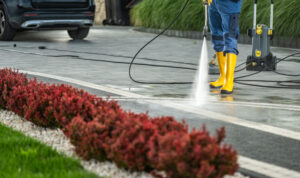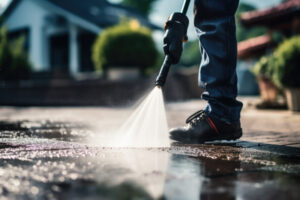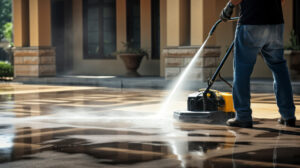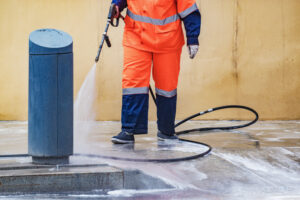I still remember the look on my face when my home inspector pointed to the north side of my roof and said, “That’s not a shadow—that’s alive and eating your shingles.”
After dropping some serious cash on my first home, discovering that microscopic organisms were literally consuming my investment wasn’t exactly welcome news.
Turns out, professional power washing isn’t just about curb appeal—it’s about protecting surfaces most of us don’t even think to maintain until something goes terribly wrong.
The Invisible Deterioration We All Miss
We’re conditioned to notice the obvious—peeling paint, cracked concrete, loose shingles.
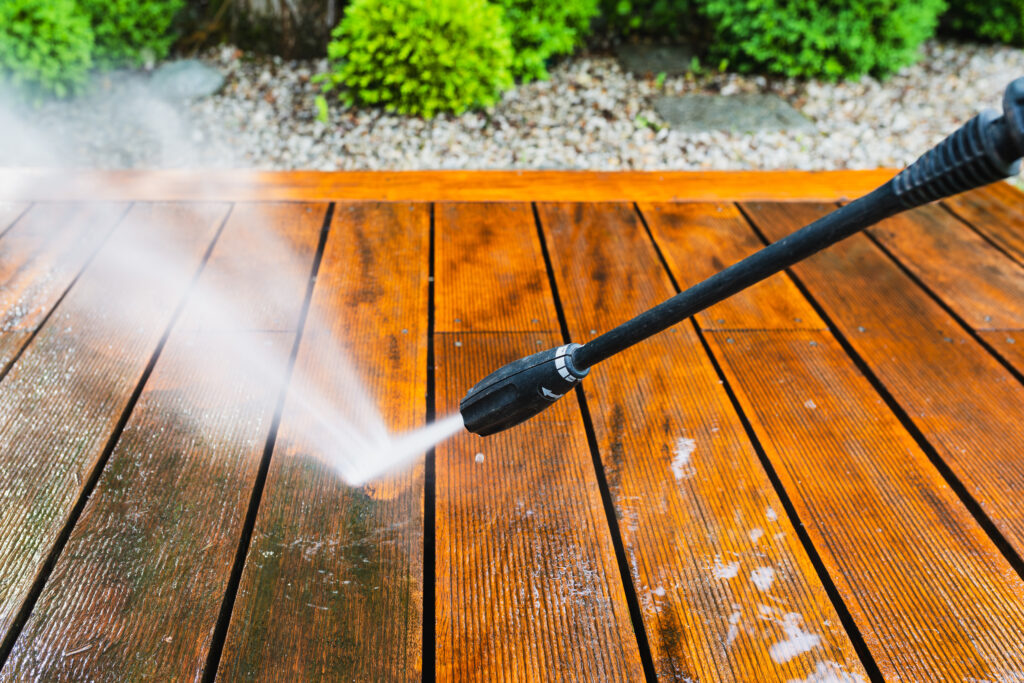
Cleaning Terrace With A Power Washer
But the slow, gradual breakdown happening on virtually every exterior surface often flies under our radar until damage becomes structural. What makes this particularly frustrating is how preventable most of it is.
When my neighbor Tom finally had his neglected deck professionally cleaned, the technician collected almost half an inch of biomaterial from the spaces between boards—material that had been trapping moisture against the wood for years, functioning like a constant wet sponge against the joists. “Your deck has been taking a bath for about five years straight,” was how the technician put it.
The Roof Above Your Head
Most homeowners operate on a simple roof maintenance philosophy: if it’s not leaking, it’s fine. But your roof faces a biological onslaught that happens in slow motion.
Those black streaks creeping across your shingles aren’t dirt—they’re colonies of cyanobacteria feeding on the limestone filler in asphalt shingles. Left unchecked, they create the perfect damp environment for moss, which physically separates shingles as it grows. The roots actually lift the edges, creating water channels where none should exist.
Professional roof washing uses low-pressure systems with targeted biocides that kill these organisms without damaging shingles. The difference between this approach and DIY attempts isn’t just results—it’s risk management. Nobody needs to discover their ladder confidence was misplaced three stories up.
Textured Concrete That Holds Secrets
Standard concrete may seem impervious to damage, but decorative concrete—those lovely stamped patios and walkways—tells a different story. The same textures that make it visually interesting create hundreds of tiny depressions where moisture and organics collect.
Last spring, I watched my stamped concrete patio transform from “pleasantly weathered” to looking brand new after professional washing removed years of trapped material. The technician explained that freeze-thaw cycles force moisture into every depression, and without regular cleaning, this accelerates the breakdown of the concrete sealer. Once that protective layer fails, the concrete itself begins deteriorating from within.
Outdoor Fabrics Playing Host
We treat our outdoor textiles as disposable, accepting their gradual deterioration as inevitable. But that pricey Sunbrella awning or those “all-weather” cushions? They’re actually engineered to last decades with proper care.
What destroys them isn’t UV exposure alone—it’s the combination of sunlight with accumulated organic material that creates perfect conditions for mildew to establish deep in the fibers. Professional fabric cleaning removes both visible stains and invisible spores, while preserving the textile’s protective coatings.
The Places We Never Think To Look
Between and Beneath: The Hidden Surfaces
Some of the most vulnerable areas of our homes exist in the spaces we rarely see: the underside of decking, the gaps between fence boards, the narrow space between your home and an adjacent walkway.
These shadowed, often damp areas become perfect incubators for the very organisms that accelerate deterioration. Professional washers bring specialized wands and techniques that access these overlooked spaces, removing established growth before it can spread to more visible areas.
Solar Investments Going Dim
The clean energy revolution has brought solar panels to countless rooftops, but many owners don’t realize their efficiency drops dramatically with accumulation. Unlike windows that show dirt obviously, solar panels can lose 25-30% efficiency while still looking relatively clean to the naked eye.
Professional solar panel cleaning uses deionized water systems that remove efficiency-robbing residue without leaving mineral deposits that actually attract more dirt. When each percentage point of efficiency represents real dollars on your utility bill, this maintenance pays for itself.
Outdoor Kitchen Reality Check
That beautiful outdoor kitchen seems maintenance-free until you look closely at the natural stone countertops or the spaces between your built-in appliances. What appears as simple discoloration often reveals itself as biofilm—a complex community of bacteria protected by a slimy matrix they create.
These biofilms not only look unappetizing but can harbor pathogens in food preparation areas. Professional cleaning reaches the porous surfaces and tight spaces where standard household cleaners and methods fall short.
The Professional Advantage
The difference between DIY enthusiasm and professional results isn’t just about equipment—though that certainly matters. It’s about understanding material science: knowing exactly how much pressure porous stone can handle versus fiber cement siding, recognizing which cleaning agents will damage which surfaces, and identifying problems before they become visible to untrained eyes.
In maintenance, timing transforms outcomes. Professional washing services don’t just clean what you can see—they address what you don’t see before it becomes a problem you can’t ignore. Sometimes the most important maintenance isn’t about fixing what’s broken, but preventing the break altogether.

